As a SaaS founder, churn is something I have to deal with repeatedly.
It's one of those things that are hard to digest - your team put great thought, care and effort to build a product and then someone out there decided it was not good enough for them.
It feels personal - but it's not.
The key to preventing churn is understanding that all churn is not the same:
- Some people cancel because they don't have the problem your product solves.
- Some people cancel because they used your product to solve their problem, and don't need it anymore.
- Other people cancel because the product is not good enough at solving the problem.
There's a clear difference between preventable and non-preventable churn. This is why no product in the world can claim a 0% churn rate. Some churn is never preventable.
The goal for SaaS businesses should really be to get preventable churn to 0%. Even that is a huge ask - but it's at least more realistic.
As the founder of a SaaS product whose primary goal is reducing churn, this is a topic I feel qualified to write about. I have done extensive research and had the chance to apply that knowledge in practice with dozens of our clients.
📢 Why Listen to Me?I’ve helped dozens of SaaS businesses reduce churn with cancellation flows, customer health scores and winback campaigns.
In this article, I will cover the top 10 strategies I have used - or helped our clients use - to address churn.
What is customer churn prevention?
Customer churn prevention is the process of implementing strategies to reduce preventable customer churn.
If you're serious about reducing customer churn, you need these Top 10 Customer Success strategies in place to increase customer retention.
Table of Contents
- Analyse churn feedback
- Provide custom cancellation flows
- Identify customers with high churn risk
- Address delinquent churn
- Focus on product-customer fit
- Customise onboarding
- Conduct QBRs to proactively reduce churn
- Have dedicated CSMs to engage with users
- Make users upgrade to annual plans
- Win-back campaigns to churned users
Customer Churn Prevention (Why Does It Matter?)
Reducing churn increases customer lifetime value which allows companies to spend more money to acquire each customer (cost of customer acquisition).
For SaaS businesses, high churn is devastating. Churn kills growth.

Companies can only grow sales using these 3 methods:
- Acquire new customers
- Upsell existing customers
- Reduce churn
Companies are extremely focused on methods #1 and #2. But they neglect method #3.
The good news is that for that reason, relatively small changes quickly make relevant gains.
That's what these 10 strategies are all about.
Top 10 Strategies to Prevent Customer Churn
-
Analyse churn feedback
- Churn per Reason. This is incredibly useful to determine product direction.
- Churn per Plan. This helps show the differences between the experiences of users on different plans.
- Offer Performance. This helps show which offers are better able to prevent churn at the moment of cancellation.
- Churn per Stage. This informs the business of when users cancel their experience, relative to their sign up date.
- What led you into searching for a solution for your Problem X?
- How did you find us?
- Why did you initially sign up for our tool? (Did you search for other tools too?)
- What made you think our tool was not for you?
- How are you solving your Problem X now?
-
Provide custom cancellation flows
- Loss Aversion. Show users what they will lose if they cancel.
- Exit Survey. Ask users the main reason for cancellation.
- Custom Offer. Provide a custom offer based on the cancellation reason.
- Feedback. Collect qualitative feedback if users are willing to share.
- Process Cancellation. Let users effectively cancel their account.
-
Identify customers with high churn risk
- Churn signals.
- Rule-based Score.
- ML-based Score.
-
Address delinquent churn
-
Focus on product-customer fit
-
Customise onboarding
-
Conduct QBRs to proactively reduce churn
- The past implementation of the product
- The outcomes the product drove for the client
- The plan for how to optimize value for the future
-
Have dedicated CSMs to engage with users
-
Make users upgrade to annual plans
- You offer them a slight reduction in price for buying upfront and get a more money upfront and a much lower churn rate;
- The client gets a better rate and avoids the hassle of processing invoices on a monthly basis.
-
Win-back campaigns to churned users
The first logical step to reducing churn is reviewing and analysing churn feedback.
You want to find the patterns behind the reasons why users are churning. Customer churn analysis can be conducted using quantitative and qualitative methods.
Quantitative methods
Quantitative methods include reviewing a churn dashboard. Here's an example of what that looks like:
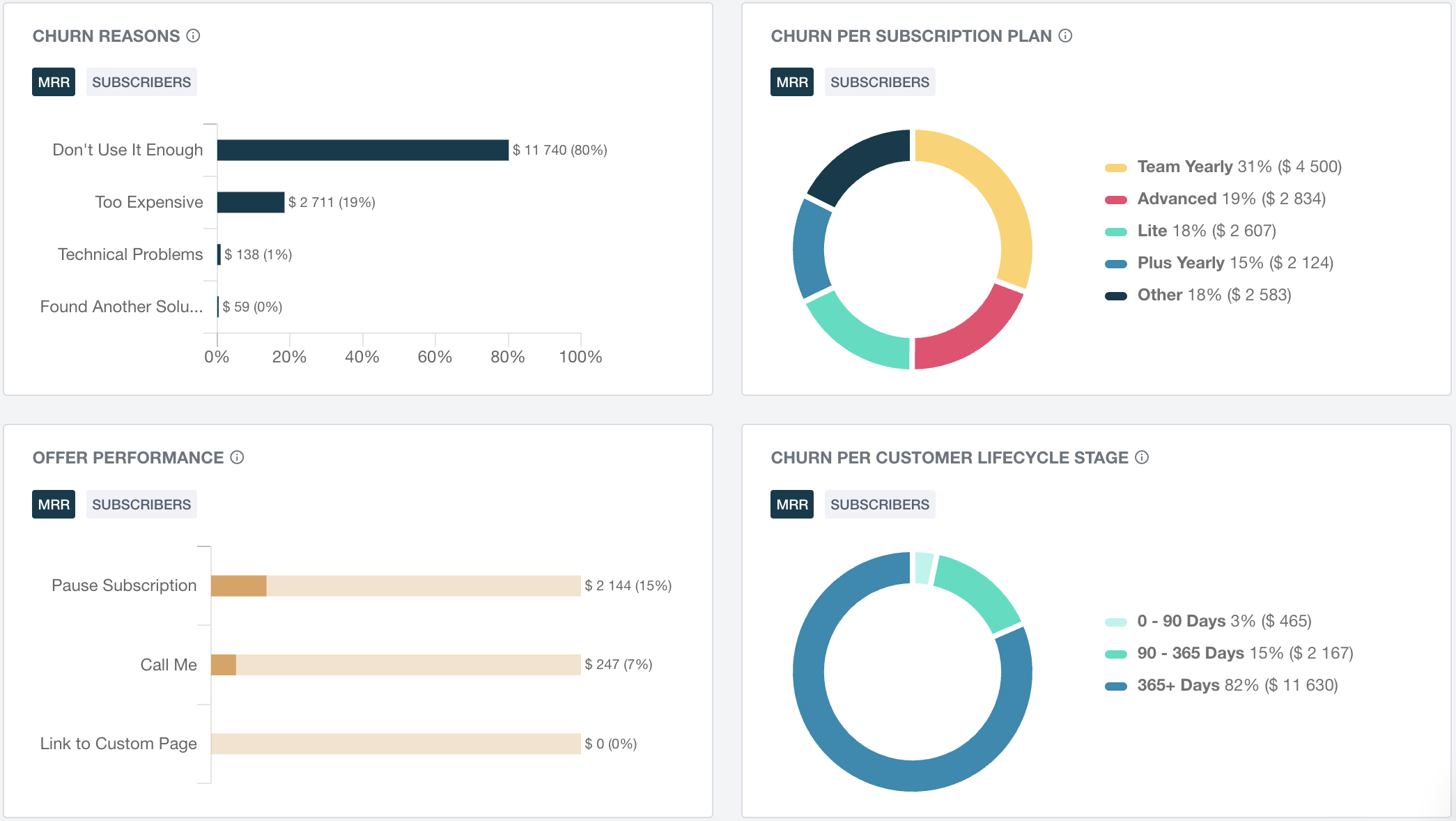
This dashboard is available to all Raaft users and it lets SaaS businesses map out:
Qualitative methods
At the same time, Raaft also provides qualitative data. Churned users are prompted to provide feedback about their experience using the product.
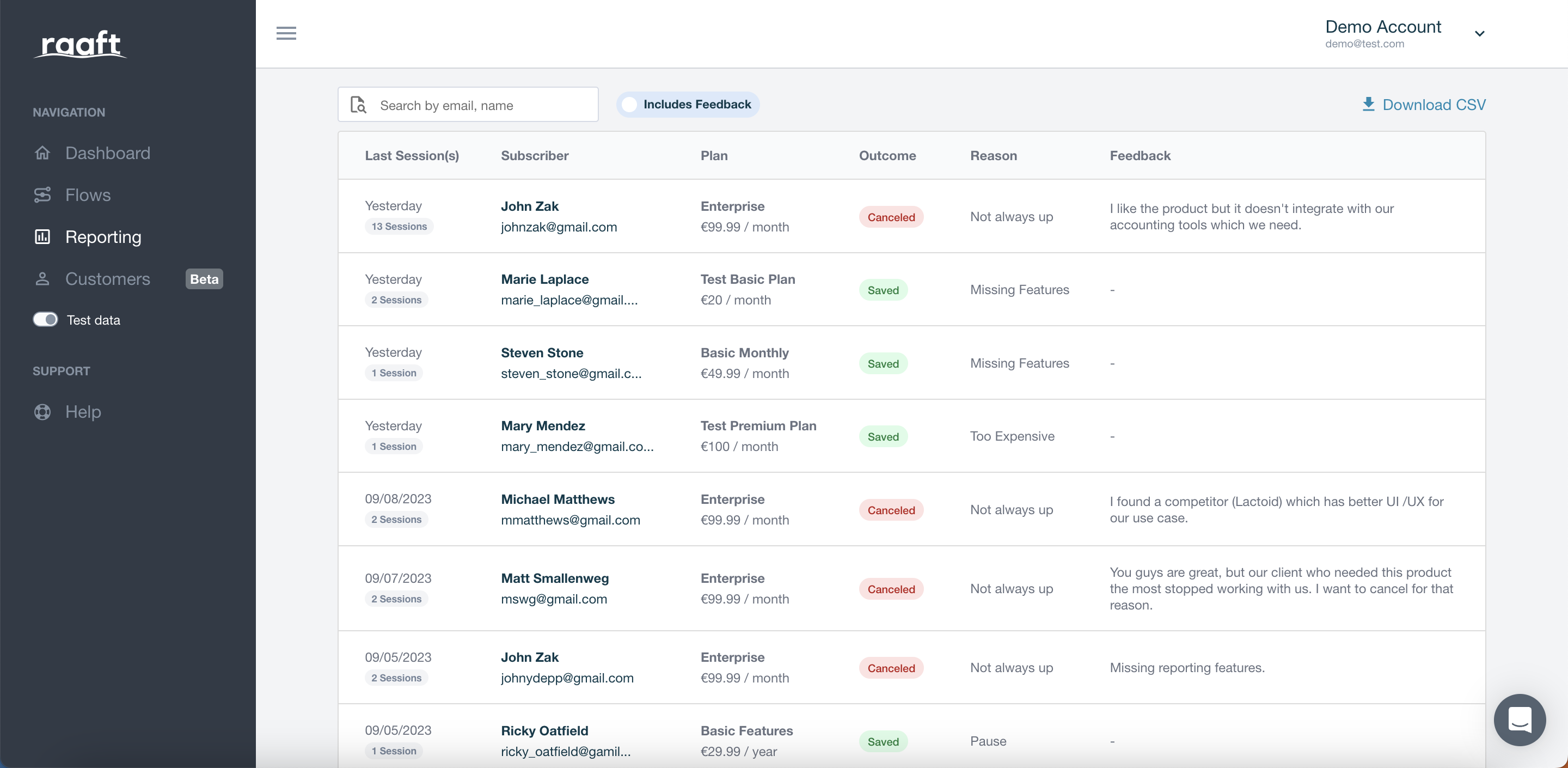
A great way of collecting qualitative churn data is by offering churned users a $50 voucher in exchange for a 15-minute conversation where they share their experience.
Ask churned users these 5 questions:
These questions allow you go to a step further and to understand the deep motivations of each customer. It allows you have a clearer justification of their decisions.
You really only need to do 3-5 of these to completely change your perspective on why users churn.
About 20% of users who start to cancel a subscription can be retained.
This is particularly true for consumer and prosumer products with relatively low prices (below $200 / month).
However, in order for them to be retained, there should be an offboarding process that includes 5 elements:
Here's an example below of what a Custom Offer looks like in practice.
This one is used by LinkedIn to retain users (check out Spotify and Adobe for inspiration).
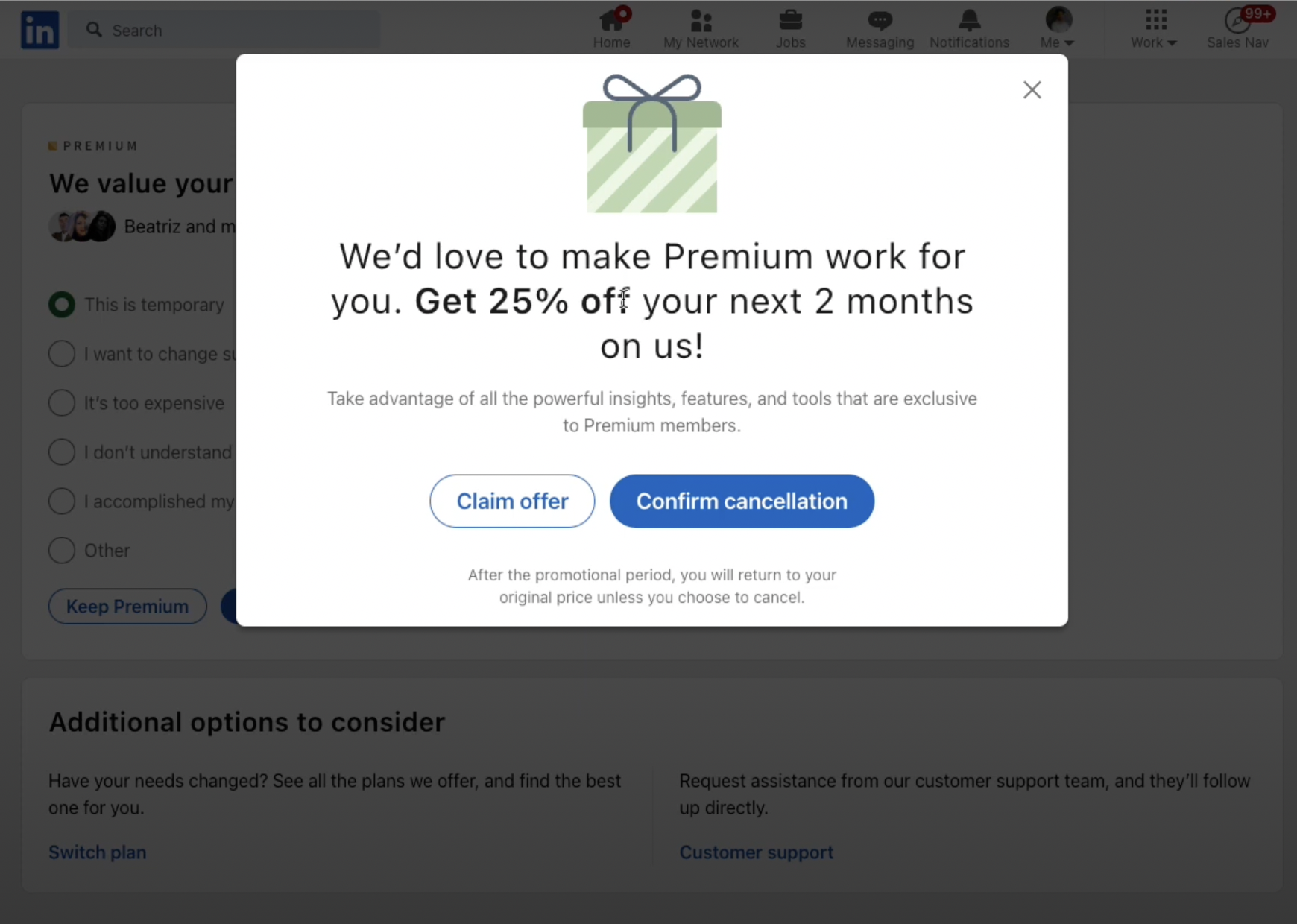
A cancellation flow is one of the easiest quick-wins products can realize with under 30 mins of setup work. They start saving customers on auto-pilot from the moment they are set up.
The best cancellation flows are able to retain some users, get additional feedback about why users cancel but still allow users to do it without much hassle.
If you're interested in setting up a cancellation flow, check out Raaft.
This is a practice that is growing in popularity across the SaaS industry. In fact, there are multiple Customer Success platforms that advertise this feature. They usually call it a 'customer health score'.
What is customer health scoring?
Customer health scoring is the practice of giving each customer a score based on their predicted likelihood to cancel their subscription.
However, it's safe to say that this is a problem that is yet to be solved accurately.
There are 3 main strategies used in the industry to determine Customer Health Scores:
This method identifies users who have demonstrated some signals highly related to churn. The obvious examples are if they failed payments or visited the cancellation flow but did not end up cancelling.
This is the low-hanging fruit of the health score: it's relatively easy to set up and can bring significant rewards.
Here's an example of what we have for Raaft customers.

This is the solution used by most Customer Success Platforms (Vitally, Gainsight, etc.).
These platforms ask Customer Success Managers at the company to set up a given score per each category for users. Score are usually weighted and then rated green - yellow - red.
Example: if onboarding users haven't logged in to their account for the past 7 days, that increases the churn risk by 20%.
These scores can be helpful, but they require additional work to integrate multiple data sources. At the same time, they might not be that realistic if they're not decided based on data analysis.

There are a few companies that are approaching the health score issue the other way around. Instead of relying on CSMs to define health scores, they ingest all the data to create a health score based on machine learning models.
This sounds extremelly appealing, but the truth is that these approaches still have quite significant disadvantages. They require a lot more manual setup, significant data cleaning and are highly sensitive to a few factors.
One of the few companies that is doing this well is Churned. It's worth checking them out.

Delinquent churn is an issue most SaaS companies have to deal with. Nowadays, payment processors already tend to have built-in tools to handle this.
Stripe, for example, has a module that enables recover and retention automations.
It lets users define rules to retry charging the payment methods and cancellation confirmation emails.
Other dunning products exist, such as Baremetrics or Paddle if you need a more advanced solution to this problem.

Some users are more valuable than others. To reduce churn, you need to focus on acquiring users that are the best fit for the problem you are solving.
Of course, this is easier said than done. Especially when you have a sales team that carries a quota. They have a direct financial incentive to sell as much as possible to whomever buys.
Unfortunately, there is no silver bullet to solve this situation.
One potentially useful concept is to try to understand and map out the main reason why a new customer signed up (through a call or a survey).
Some reasons are better than others. The worst ones usually come with increased churn.
Align expectations and define an Ideal Customer Profile. Try to get the team to stick to it when selling.
Onboarding is a crucial step for long-term retention. Users that are able to realize value quickly are much more likely to stay for the long run.
One of the ways of doing this is with custom onboarding for different target users.
Here's an example of how Loom understands the primary goals and characteristics of each new user. This information can then be used to improve the onboarding experience and maximize adoption.
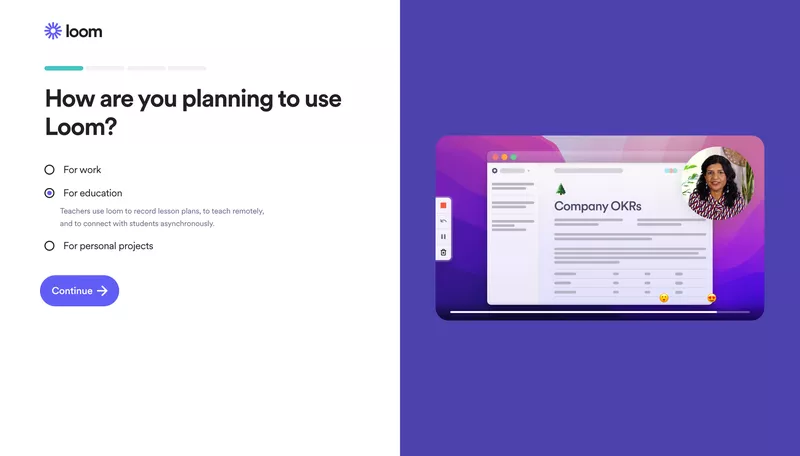
What is a QBR?
QBR stands for Quarterly Business Review. It's the process Customer Success Managers use to communicate with clients on a quarterly basis.
A QBR is used for the CSM to go over:
It's extremely useful to identify customers who are at risk of churning, as well as those most likely to want to upsell.
Here's an outreach template suggested by Catalyst to reach out to clients to schedule QBRs.
Thank you very much for your continued use of [your product].
In an effort to ensure you always get the maximum benefit from our services, we invite you to join us in a Quarterly Business Review session.
This QBR will be an opportunity for us to connect and share results and feedback on your usage of [your product]. You’ll have the opportunity to voice what has been going well in our business relationship, and what can still be improved.
I’m confident that this session will give you incredible value and improve the results you’re getting from [your product].
Can we schedule a time? Here's the link to book a time in my calendar if that's easier.
Regards,
[name]If they don't answer, that might be a signal the client is more likely to churn.
One of the most useful roles to hire for early on is a Customer Success Manager. This should be a person who is doing more proactive than reactive work to retain users.
The CSM should be proactively reviewing accounts (potentially rank-ordered by a Customer Health Score as mentioned on point #3) and making sure that any potential issues are dealt with in a timely manner.
It's common knowledge that churn is much easier to prevent if it can be caught before users make the decision to cancel. This is particularly true for B2B products.
Hiring someone for this exclusive role is vital - and not making it a hybrid role with a set of sales or customer support tasks.
Upselling customers from monthly to annual plans is a very effective way of reducing churn.
It can easily be a win-win scenario:
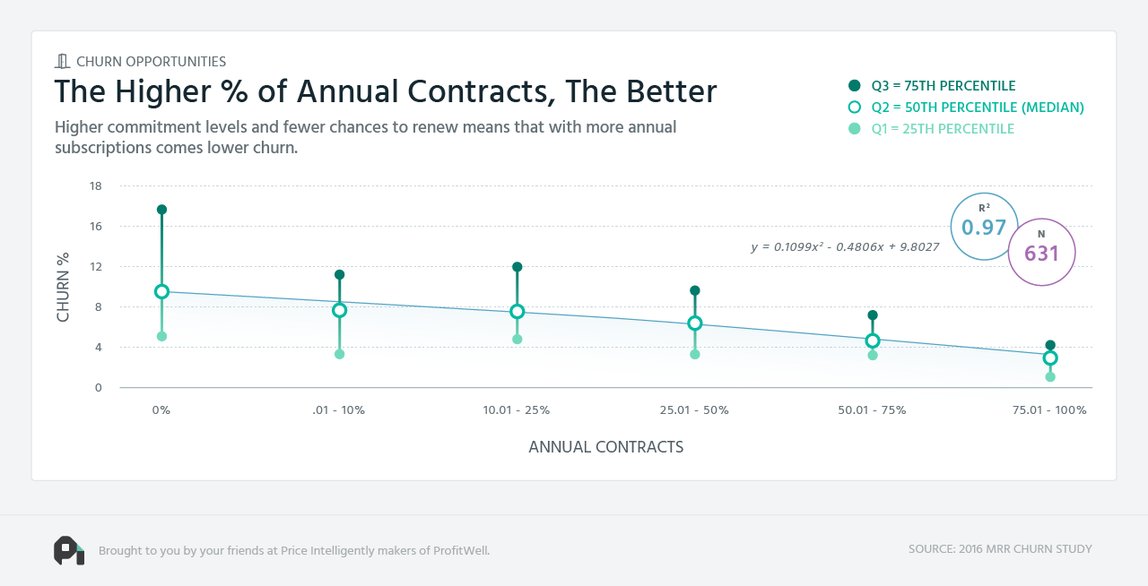
Churned users are not necessarily lost forever.
They may have cancelled due to seasonality factors. Or they may have cancelled because the product lacked features that were added in the meantime.
Churned users can be contacted 2, 6 or 12 months down the line.
Here's an example of a win-back email I received from Magical. It highlights what's changed since I stopped using the product.

Best Churn Prevention Tool in 2023
There are several tools at your disposal to prevent churn. From cancellation flows to dunning solutions or win-back campaigns, you should embrace multiple strategies. No tool can serve them all.
One of the tools that's the easiest to implement for quick-wins is Raaft. It can help you increase retention and provide better churn reporting, which in turn helps improve your product.
If you're ready to get started, you can try Raaft for free today.
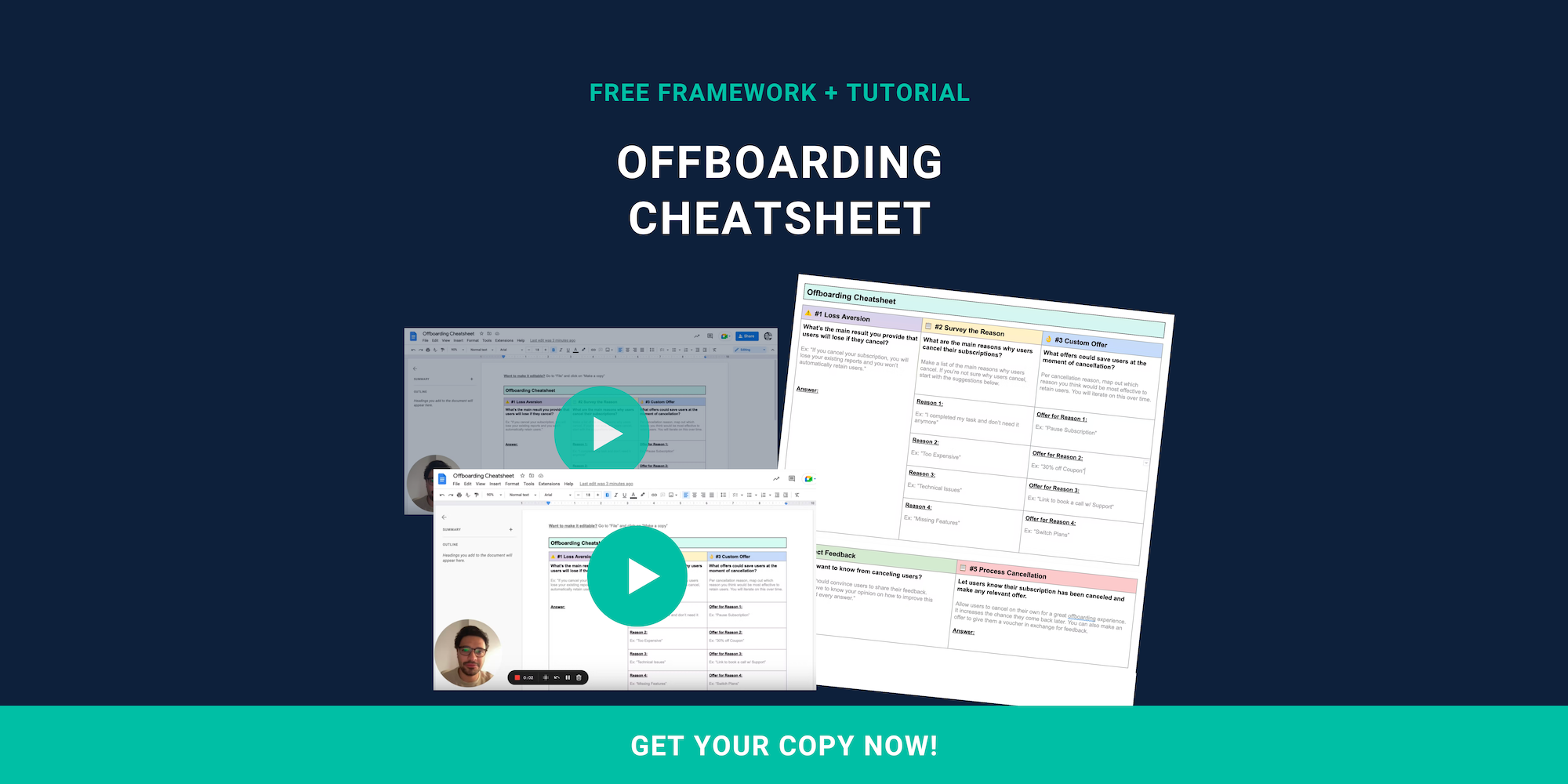
Offboarding Cheatsheet
This framework + video tutorial will help you design a better cancellation process.
Some of our featured articles

Adam Crookes

Miguel Marques

Adam Crookes
Customer Success insights in your inbox
Helping Founders and Customer Success Managers handle customer retention effectively.
We will only ever send you relevant content. Unsubscribe anytime.


